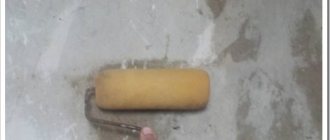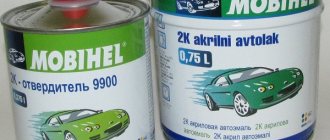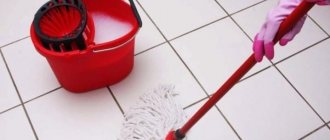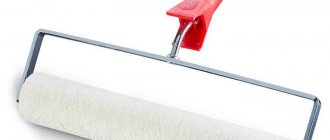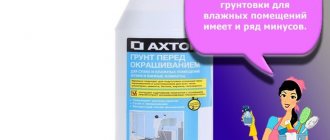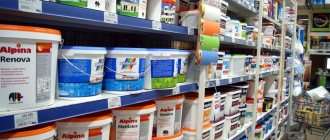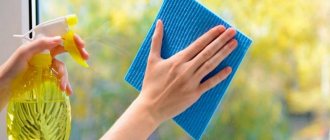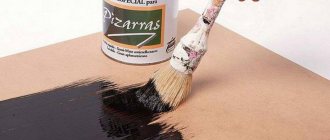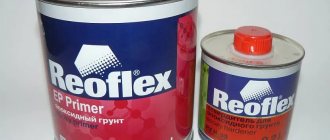Greetings. The task is to correctly apply paintwork to prepared light-alloy aluminum wheels.
The front side of the discs was pretty damaged by the previous owner - dents, scratches, age-related peeling of the LPK. The wheels have been completely cleaned from the factory coating. The soil was something - more like thin rubber plastic or something...
After complete degreasing (degreaser + anti-silicone), the dents were filled with NOVOL ALU
(two-component putty with aluminum dust). After drying for a week, the entire front surface of the discs was sanded with P240 wet.
DIDN'T YOU GET UP ANYWHERE ABOVE? DID YOU DO EVERYTHING MORE OR LESS CORRECTLY?
There is a cheap Fubag Master G600/1.4 HVLP spray gun with a 1.4 nozzle
. A pressure regulator is included. Pulvik disassembled, washed and adjusted. There is a compressor with the necessary output of clean air.
And then the main question of this entry is how and with what to properly prepare and paint these wheels for painting?
0. Dry the discs (IR lamp, hair dryer, sun). 1. Scotch byte, blow off, degrease (two napkins - wet and dry). 2.1 Acid soil
– better adhesion, but allows moisture to pass through.
Apply a reactive (thin) layer. or 2.2 Epoxy primer
- adhesion is slightly worse, but does not allow moisture to pass through.
The best protection against mechanical influences. 3. Scotch byte, blow off, degrease (two napkins - wet and dry), sticky napkin. 4.
Gray
acrylic primer, Dry, grind P320 with developing powder, large parts - through a block, fines and edges - by hand. Finally rinse with P400-600 on a wet surface. 5. Blow off, degrease (two napkins - wet and dry), sticky napkin. 6. Base enamel
3 layers (the first layer is “dry”, spray a thin layer, the remaining two layers are full) 10-15 minutes between layers, adhesive cloth.
7. Acrylic varnish
3 layers (the first layer is “dry”, spray in a thin layer, the remaining two layers are full) 10-15 minutes between layers.
Any metal parts, including aluminum, need priming before painting. Without primer, paints and varnishes adhere very poorly and quickly begin to peel and fall off the surface. To maximize the life of the paint, a special primer for aluminum should be used. This article will discuss the stages of preparing a metal surface, characteristics, types of primers, and the technology for applying different primer solutions.
Painting aluminum parts
Anyone who has painted aluminum knows that this is not a very easy task. If you paint aluminum products without preliminary preparation, the paint will lay down in an uneven layer, unevenly, and after a short period of time it will begin to peel off. Paint does not adhere very well without the use of a primer because:
- aluminum has a smooth surface. This metal has a peculiar crystal lattice, due to which the surface structure is very smooth. When painting, the smallest particles of paint have nothing to cling to, as a result of which they lie rather poorly on the base, and after some time they gradually fall off;
- high surface tension. Aluminum is a complex metal; its molecular bonds create strong tension on the surface, causing the surface to appear very slippery, and at the same time as if greasy. A high surface tension significantly reduces adhesion, that is, the adhesion of the base to the paint and varnish material;
- aluminum has an oxide film. This metal in its pure form reacts very quickly with oxygen contained in the air, as a result of which a durable layer of oxide film appears on the surface. This layer, which is visible to the naked eye, is manifested by corrosion, which has a heterogeneous structure and poor adhesion to other materials, including varnishes and paints.
Important! The more time passes, the thicker the oxide film becomes, it takes the form of peeling, loose corrosion foci, they slowly spread over the entire surface, while the aluminum becomes thinner, and the surface layer affected by corrosion will fall off along with the paint applied to it.
Primer for aluminum: primer for aluminum, for boats, for aluminum wheels
Repair and decoration
04/11/2018 Anastasia Prozheva
Aluminum products are used in various spheres of life. Non-ferrous metals can be painted, but before doing this the surfaces must be properly prepared. That is why it is important to choose the right primers for aluminum and know the main rules for using this material. Today I will tell you the standards for recognizing primers so that the quality of the finish does not suffer in the future.
Primer for aluminum
What problems may arise
A misunderstanding that may arise when painting an aluminum surface is its excessive and perfect smoothness.
The fact is that the complex structure of the surface, which has roughness, increases adhesion. It is this fact that gives a high-quality result when applying paint.
All this is absolutely absent on the aluminum surface. In order to solve this problem, you need to do the following:
- Performing the rough grinding process manually or using a grinder.
- Acid etching, which is possible due to the instability of aluminum to aggressive agents.
Note that aluminum wins in this regard. When it comes to steel surfaces, this is where real problems arise. This material is strong and cannot be sanded particularly well. It is also resistant to acid etching.
In the video: aluminum primer.
Painting aluminum parts
Anyone who has painted aluminum knows that this is not a very easy task. If you paint aluminum products without preliminary preparation, the paint will lay down in an uneven layer, unevenly, and after a short period of time it will begin to peel off. Paint does not adhere very well without the use of a primer because:
- aluminum has a smooth surface. This metal has a peculiar crystal lattice, due to which the surface structure is very smooth. When painting, the smallest particles of paint have nothing to cling to, as a result of which they lie rather poorly on the base, and after some time they gradually fall off;
- high surface tension. Aluminum is a complex metal; its molecular bonds create strong tension on the surface, causing the surface to appear very slippery, and at the same time as if greasy. A high surface tension significantly reduces adhesion, that is, the adhesion of the base to the paint and varnish material;
- aluminum has an oxide film. This metal in its pure form reacts very quickly with oxygen contained in the air, as a result of which a durable layer of oxide film appears on the surface. This layer, which is visible to the naked eye, is manifested by corrosion, which has a heterogeneous structure and poor adhesion to other materials, including varnishes and paints.
Important! The more time passes, the thicker the oxide film becomes, it takes the form of peeling, loose corrosion foci, they slowly spread over the entire surface, while the aluminum becomes thinner, and the surface layer affected by corrosion will fall off along with the paint applied to it.
Primer brand VL-02
We present one type of primer marked VL-02, which is manufactured according to all standards established in GOST 12707-77. Let's study all its properties in detail. Aluminum primer VL-02 is a two-component composition based on acid thinners. We list the components that are used for the primer base:
- Zinc Crown Concentration is a yellow pigmented substance with anti-corrosion properties.
- Synthetic polymer polyvinyl butyral - is formed as a result of the interaction of butyraldehydes and polyvinyl alcohol. Thanks to this composition, the primer acquires high adhesion to the surface of non-ferrous metals. Moreover, after applying the paint it will be resistant to mechanical stress.
- Acidic additives that dissolve the surface are alcohol-water solutions with orthophosphoric acid.
How to apply VL-02 correctly
If the primer for aluminum is not applied according to technology, you cannot vouch for the quality of the work performed. Here is the procedure for performing priming work:
- Before use, the soil must be thoroughly mixed and poured into a container designed for acidic compounds, preferably glass.
- Next, combine the composition with an acid diluent in a ratio of 4:1.
- After waiting for up to half an hour, everything is thoroughly mixed again. It is necessary to stand to allow complete dissolution of the solutions. When diluted, the shelf life of the composition is up to 8 hours.
- After this, the composition is applied to the surface in a thin layer. Application can be done using a brush or spray. After finishing the work, leave it to dry. It usually takes about an hour.
Consumption and precautions
Before purchasing a primer, it is important to familiarize yourself with the composition consumption, which can vary from 80 to 120 g/m2; this is true if the thickness of one layer is equal to the limit from 8 to 15 microns. Professionals advise applying about 2 layers.
On sale you can find this primer, which is presented in a yellow base color. It is important to take precautions when applying this primer.
When carrying out internal work and after its completion, it is necessary to ventilate the room, and in the process of applying the mixture, you must use personal protective equipment. The cost of one kilogram of such primer is 233 rubles.
BODY brand primer
An alternative to the domestic primer is the primer from BODY. And there are several options:
- primer for non-ferrous metals BODY 969;
- aerosol acid etching primer BODY.
How to prime correctly
The priming process is not complicated and is similar to using standard primers:
- the base is thoroughly cleaned and washed to remove all contaminants;
- the surface is treated with degreasers or conventional solvents;
- layer of soil. If you need to treat a small surface, then all work can be done with a brush. To treat the entire body, it is better to use a sprayer. There is no need to make a thick layer or pour the body generously. 1 thin layer will be reliable protection;
- within 2 hours, chemical reactions will occur and a protective surface will form on the metal body;
- Apply standard primer (acrylic).
Note. To apply an even layer of coating, use a spray bottle; application with a brush can be uneven, resulting in varying thicknesses and gaps.
Suitable types of paints
In addition to using the correct primer, it is necessary to select a coloring composition. Both materials must be suitable for each other in composition. Otherwise, you may get unpleasant surprises.
Let's consider several options during which the process of painting objects that function in harsh conditions is implemented. For example, painting car rims, motor boats and aluminum boats.
It's no secret that there are paints that have different bases. Let's try to figure out how they behave when painting an aluminum surface.
Alkyd-based compositions
For finishing application on the aluminum surface, alkyd-based paint PF-115 is used. It has the following characteristics:
- high degree of adhesion to non-ferrous metals;
- resistance to any kind of climatic conditions;
- inertness to the effects of fuels and lubricants.
Coverage is achieved by applying two layers of primer and two layers of enamel. Be sure to let each layer dry thoroughly, only then apply the next one. After applying the last layer, the paint dries from 24 hours to 3 days. It depends on the condition of the enamel and its consistency.
Important! To speed up the drying process of the enamel, it is diluted with white spirit or solvent before application. You can also practice the method of heating the surface to 40–450C.
Perchlorovinyl coloring compounds
These are paints that are used for finishing application on aluminum surfaces. Among them are the products XB-16 and XB-124. These compositions are made on the basis of glyphthalic and perchlorovinyl resins, which are characterized by the resistance of pigments to exposure to light.
After the paint dries, it has the following properties:
How to properly prepare aluminum
In order for varnishes or paints to adhere perfectly to aluminum and adhere firmly to it, the base must be properly prepared before using a primer. When manufacturing aluminum parts at a factory, preparing this metal is a complex process, but even at home you can prepare aluminum well. Before using aluminum primer for painting, the following preparations must be completed:
- Clean the surface mechanically. It is very important to remove dust, dirt, old paint and oxide film from the metal. The best tool for this cleaning is a sandblaster, but if you don't have one, you can use coarse sandpaper, a coarse file, or a sander with a special protective disc. Aluminum needs to be cleaned to a shine.
- The base is degreased and etched. These procedures are needed to remove a continuous oxide layer, greasy, oil stains from a metal surface. Degreasing is carried out using alcohol, acetone or solvent. After this, small aluminum products can be dipped briefly into a plastic container in which phosphoric acid and water have previously been diluted. Large parts or structures must be coated with the same orthophosphorus solution using a brush or foam rubber. This procedure must be performed strictly with rubber gloves, thick clothing and goggles.
- Creating a conversion layer. At home, such a layer can be created using zinc phosphate, which is applied to purified aluminum. Zinc phosphate does not undergo a corrosive process; it has a rough structure, so it is very suitable for smooth aluminum parts, providing a high rate of adhesion of the base to the paint and varnish material applied after priming.
- Washing and drying. It is necessary to rinse the base to completely remove chemicals from it that would interfere with the application of the primer. After washing under running water, the product is dried either using a hair dryer or in the open air.
- Applying primer. At this stage, the primer is applied in one or more layers. When the primer dries, the base will be covered with a polarized protective layer, which will become an excellent base for applying paint and varnish material.
Attention! Typically, primer for aluminum contains harmful and toxic components that have a detrimental effect on human health. To be on the safe side, the primer should be applied to the aluminum either in a very well ventilated room or outdoors. It is important to use personal protective equipment such as gloves, goggles and a respirator.
Method 1
In order to carry out the procedure of anodizing and painting aluminum you will need:
- salt, soda, boiled water for preparing an electrolyte solution - aluminum container in which our part or product will fit - fine sandpaper - current source (about 2A and 12V) - acetone or kerosene for degreasing - aniline dye and acetic acid for preparing paint
Instructions for painting aluminum with anodizing
1 First we need to make electrolyte at home. To do this, you need to prepare two saturated solutions - salt and soda. We add salt to one container with boiled water, soda to another, stir, add more, stir again and do this for 25-30 minutes so that the solutions are maximally saturated with salt and soda. Leave them for another 15-20 minutes, filter and mix in a GLASS CONTAINER in the proportion of 9 parts of soda solution to 1 part of salt solution 2 Take our aluminum part or product and carefully treat the surface with fine sandpaper 3 Degrease the surface using acetone, kerosene or a special liquid for degreasing 4 Rinse the aluminum part in water. After rinsing the part in water, try not to touch it with your hands, as your hands may leave stains on the surface that will affect further processing of the product. 5 We pour the electrolyte we have prepared into an aluminum dish - a basin or pan - and place our aluminum product there. To start the anodizing process, we connect the current source with a plus to our product, and a minus to the aluminum container. As a current source, you can take a car battery or an adjustable rectifier (the current should be about 2 Amperes, the voltage should be about 12 Volts). Anodizing should be carried out within 1.5 - 2 hours, during which time our aluminum product will acquire a pleasant bluish-gray tint. 6 How to paint aluminum? Anodized aluminum should be painted with an aniline dye solution. To prepare such a solution, you need to add 15 grams of dye, 1 ml of acetic acid to 1 liter of water and heat it to 70-80 degrees. We immerse our aluminum product in the dye solution for 10-15 minutes, the longer we keep the product in the dye solution, the more saturated and dark its color will be after dyeing
| Zinc-aluminum paint for all metals | Anti-corrosion zinc primer for aluminum | Aluminum-zinc primer for steel and non-ferrous metals |
Types of primers for aluminum
Nowadays, two types of primer are used to prepare aluminum for painting.
- Aerosol primer for aluminum. This primer is supplied in cans; the aerosol is acid-free and is most often used for treating small aluminum products. It covers, for example, bicycle frames, car rims, etc. This type of primer is very easy to use; it can be used in the garage and even on the balcony. The primer is completely ready for use, dries in a couple of hours, but does not have high resistance to mechanical stress. Primers are sold in the form of aerosols in car dealerships and construction hypermarkets. When choosing such a primer, you need to look at the packaging; it should indicate “Primer for Aluminum” or “Alu Primer”. It is best if the composition contains zinc powder, in which case the package will be marked “Zn”. When choosing, you need to look at the production date and expiration date.
- A two-component primer for application on aluminum is used to protect automobile bodies, aluminum boats, boats, and other products with a large area. One of the popular and effective two-component compositions is primer for aluminum VL 02. Two-component primers must be prepared in small portions. The prepared mixture must be applied no more than 6 hours in advance; it dries on the surface in about a day. After drying, a protective film is formed that has excellent mechanical strength and high corrosion resistance. The two-component primer includes an acid thinner and a base. The base contains polymer resins and zinc powder, which creates a conversion adhesive layer. The primer thinner VL-02 consists of special alcohol for degreasing the base and phosphoric acid, for etching aluminum and creating a phosphating protective layer.
Primer application process
Depending on the type of primer, the technology for its application will differ.
- The primer in the form of an aerosol is applied to a previously cleaned surface. Before applying the primer, the base is cleaned to a shine using sandpaper. Grease stains are removed with a rag soaked in alcohol or solvent. As soon as the base is completely cleaned, you should immediately begin applying a primer to prevent an oxide film from appearing. The can is shaken several times, after which a jet of soil is applied from a distance of 20-25 centimeters, at an angle of 90 degrees to the surface. To avoid drips, the spray head must be constantly moved, without stopping in one place. Half an hour after the applied layer has dried, it is advisable to cover it with another layer. This primer dries completely in about 2 hours, after which it can be painted.
- Two-component primers are prepared in a plastic container that is resistant to acid. A container of about one liter is sufficient; the base and thinner are mixed in it in a ratio of 4 to 1. The mixed primer is left for half an hour, after which the solution is mixed and applied to the previously cleaned base.
The process of applying two-component primer is best done with a pneumatic spray gun, but you can use a regular foam roller. It is advisable to apply two layers, the second layer is applied after the first has completely dried. When the soil is dry, the product can begin to be painted.
In everyday life, products made of non-ferrous metals are very often found. Sometimes there is a need to update their appearance. In this regard, the question arises: is it possible to paint the surfaces of non-ferrous metals? This is especially true for car enthusiasts who periodically update the aluminum parts of their car. In order for the painting process to be correct and of high quality, a primer for aluminum is necessary. How to correctly recognize the right brands of primers, carry out the process of surface preparation and painting of aluminum parts?
Method 2
To paint aluminum at home you will need:
- primer for aluminum, stainless steel and galvanized coatings - fine sandpaper - acrylic or epoxy zinc-aluminum paint for metal - white spirit, acetone or kerosene for degreasing the surface
Instructions for painting aluminum without anodizing
1 Thoroughly sand the surface of your aluminum product with fine sandpaper.
The less grainy sandpaper you use, the better. Size 600, 800 or 1200 is suitable 2 Degrease the surface using white spirit, acetone or a special degreaser 3 After complete cleaning and degreasing, coat the surface with a primer for aluminum and stainless steel as quickly as possible. If you leave aluminum treated with sandpaper in the air for a long time, then after a short time it will begin to darken - this is the result of the oxidation process, and primer and paint do not adhere well to oxidized aluminum. This is why it is so important to apply the first coat of primer as soon as possible. A few minutes later, after the first layer of primer has dried, you need to apply a second layer of primer for better adhesion of the paint to your product 4 Let's move on to painting. How to paint aluminum treated with primer? To do this, you will need a special zinc-aluminum metal paint containing zinc and aluminum. It is best to use paint in an aerosol can, since when applying paint from an aerosol can, it goes on much more evenly and smoothly than when applied with a brush. Before you start painting, shake the can thoroughly; paint should be applied from a distance of 25-30 centimeters. Painting should be done from top to bottom to avoid drips. After the first coat of paint has dried (20-25 minutes is enough), apply the next coat of paint. As a rule, for good and high-quality painting of aluminum, 3-4 layers of paint are enough. 5 After painting is completed, let your aluminum product dry completely. This requires 4 - 6 hours 6 You can additionally coat the product with varnish, this will add depth to the color and additionally protect the painted surface from damage. If you have followed all the steps of the instructions exactly, the new paint on your aluminum product will last for many years and look like new !
What problems may arise
A misunderstanding that may arise when painting an aluminum surface is its excessive and perfect smoothness. The fact is that the complex structure of the surface, which has roughness, increases adhesion. It is this fact that gives a high-quality result when applying paint. All this is absolutely absent on the aluminum surface. In order to solve this problem, you need to do the following:
- Performing the rough grinding process manually or using a grinder.
- Acid etching, which is possible due to the instability of aluminum to aggressive agents.
Note that aluminum wins in this regard. When it comes to steel surfaces, this is where real problems arise. This material is strong and cannot be sanded particularly well. It is also resistant to acid etching.
In the video: aluminum primer.
Features of painting aluminum
Like all metals, aluminum is subject to the influence of the external environment, that is, corrosion can also appear on it, which has a negative effect on it. Items lose their presentable appearance and you don’t really want to use them; to avoid such consequences, paint and varnish coatings are applied to the items.
Painting an aluminum surface is slightly different from others, since when applying paint to this type of material, it rolls off, and after a short time it completely peels off. In order to avoid this, you will need to take into account some features:
- the metal surface is very smooth and the paint and varnish material cannot cling to it;
- the metal reacts with oxygen and an oxide film forms on it;
- This element is characterized by surface tension, which gives a greasy feeling and increases the sliding effect.
Attention: the presence of such features requires more thorough surface treatment before applying paint and varnish material to it. Metal surface preparation
So, before applying a dye to such an element, you must:
- pre-treat with acid this will remove fat content;
- the second stage is chromate treatment, it creates a conversion layer, thanks to which the paint adheres more thoroughly to the metal;
- Next, you need to wash off the remaining salts with water that has undergone special cleaning;
- one more step drying;
- Afterwards a primer is applied, which creates a protective layer.
Attention: the primer contains toxic substances that have an adverse effect on the human body; in order to avoid poisoning, treatment should be carried out in a well-ventilated area or outdoors, if possible.
Primer brand VL-02
We present one type of primer marked VL-02, which is manufactured according to all standards established in GOST 12707-77. Let's study all its properties in detail. Aluminum primer VL-02 is a two-component composition based on acid thinners. We list the components that are used for the primer base:
- Zinc Crown Concentration is a yellow pigmented substance with anti-corrosion properties.
- Synthetic polymer polyvinyl butyral - is formed as a result of the interaction of butyraldehydes and polyvinyl alcohol. Thanks to this composition, the primer acquires high adhesion to the surface of non-ferrous metals. Moreover, after applying the paint it will be resistant to mechanical stress.
- Acidic additives that dissolve the surface are alcohol-water solutions with orthophosphoric acid.
How to apply VL-02 correctly
If the primer for aluminum is not applied according to technology, you cannot vouch for the quality of the work performed. Here is the procedure for performing priming work:
- Before use, the soil must be thoroughly mixed and poured into a container designed for acidic compounds, preferably glass.
- Next, combine the composition with an acid diluent in a ratio of 4:1.
- After waiting for up to half an hour, everything is thoroughly mixed again. It is necessary to stand to allow complete dissolution of the solutions. When diluted, the shelf life of the composition is up to 8 hours.
- After this, the composition is applied to the surface in a thin layer. Application can be done using a brush or spray. After finishing the work, leave it to dry. It usually takes about an hour.
Soil VL-02
Soil VL-02
Let's look at soil from a domestic manufacturer that meets all GOST standards. This mixture is two-component and consists of the following parts:
- Base - thanks to the complex components in the material, the primer acquires excellent adhesion for the complex aluminum surface and becomes impact-resistant
- Acid thinner - thanks to it, the aluminum base is etched during priming
Related article: Cat door: types of passages for animals
If we talk about the method and technology of application, then adhere to the following rules:
- You need to take a glass container and pour the base into it. Don't forget that the capacity
must be acid resistant
- The acid thinner is mixed with the base in a ratio of 1:4, where 1 part of the thinner and 4 parts of the base are taken
- After this, wait 20-30 minutes and mix the resulting solution well until smooth. Be sure to wait at least this time, otherwise the polyvinyl butyral will not have time to dissolve. When the primer is ready, it should be used within eight hours
- Apply the primer on aluminum in a thin layer. You can use a spray or just take a brush. The soil dries very quickly - on average, in one hour the entire surface will dry out.
The pricing policy for the material is quite attractive and allows you to use this particular mixture for the preparation of aluminum. On average, for one kilogram of VL-01 soil you will pay about 100-120 rubles.
Important! If you use polyurethane paint, then aluminum does not need primer at all. It is enough to degrease the base well and then apply a polyurethane mixture, which itself has the properties of good adhesion.
BODY brand primer
An alternative to the domestic primer is the primer from BODY. And there are several options:
- primer for non-ferrous metals BODY 969;
- aerosol acid etching primer BODY.
Alternative primers
As mentioned above, primer and paint are two components that must fit together. But, since enamels are applied to a primer composition, we select them according to the principle of matching the primer for an aluminum surface.
The range of primers is quite wide, in addition to those considered, the following can be noted:
When choosing paints and varnishes, we advise you to purchase products from already proven companies. The compositions of such companies as Tikkurila, Hempel, Dukeson, Body and others have proven themselves well. Also, when choosing, always try to read the certificate, which displays all the necessary characteristics.
Choosing paint based on the primer used
Primer for aluminum wheels
Related article: Cross stitch cats: British cats, kits on the roof, red and black pictures, photo of the moon lazy cat
Paint and primer are components that must be selected based on each other. But if we think that the paint is applied after the primer, then we choose paintwork materials depending on the primer used. The list of primers for aluminum is very long and here are some of them:
- VL-02 and VL-08
- GF-031
- Zinc white
- EP-51 – white epoxy paint
When choosing paint, you should also focus on the manufacturer’s price. There are a lot of cheap mixtures, but many do not take risks and use only high-quality materials. For myself, I have identified several brands that have long proven themselves only on the good side. This is Tikkurila, HEMPEL, Dyukson. Always look at the palettes and read reviews about paintwork materials. In my own experience, I have already verified that white mixtures fade much faster than the discoloration of colored paints. And this is all despite the manufacturers’ stated properties of protection against ultraviolet rays.
Painting old coatings
What to do if aluminum parts have already been painted previously and require a painting process again. Here is a step-by-step algorithm of actions in this case:
- We determine the condition of the old coating. There is no need to remove old enamel unless it is flaking and is of the same type as the new paint material.
- Otherwise, the old paint should be removed with any organic remover. To begin with, the substance is applied to the painted surface and left for 20-30 minutes. To improve the effect, you can cover the surface with polyethylene. The softened paint is removed using a plastic or wooden spatula.
So, painting aluminum surfaces is possible. You just need to approach the choice of materials responsibly.
How to choose the right primer (2 videos)
Is it possible to paint over an old coating?
Using primer for aluminum before painting the boat
When all the issues with choosing a primer have been resolved, all that remains is to understand whether it is possible to apply new paint to the old one? So, there is no need to clean the surface only if two conditions are met:
- Old paint should not peel off the aluminum surface
- The old coating should not differ from the type of new paintwork material that will be used for painting
If you do not fall under these conditions, then organic removers that are used in this way will come to your aid:
- Once the remover is applied to the aluminum, cover it with a layer of polyethylene. This layer should remain on the surface for about half an hour
- Using plastic or wooden scrapers, remove the swollen mixture from the aluminum. With the help of weight washes the process will be quite easy and fast
Related article: Mechanized floor screed: machine method, wet trowel, semi-dry mechanical trowel
In order to understand whether paintwork materials are compatible with the old coating or not, conduct some experiments. This will take some time, but you will know for sure whether or not to apply primer and paint to such a surface. Using 646 solvent, dampen a piece of cloth and apply it to the aluminum. After this, put polyethylene on top of the rag and cover the edges with tape to achieve a seal. Now leave this area for at least a day and do not perform any actions on the surface. If after this the paint does not begin to swell, then the surface is completely ready for applying primer and paint of any kind.
Important! If you plan to paint an aluminum boat, never use red lead or titanium paints. These mixtures have the negative property of destroying the structure of aluminum, not to mention the rivets that are used in the production of boats.


